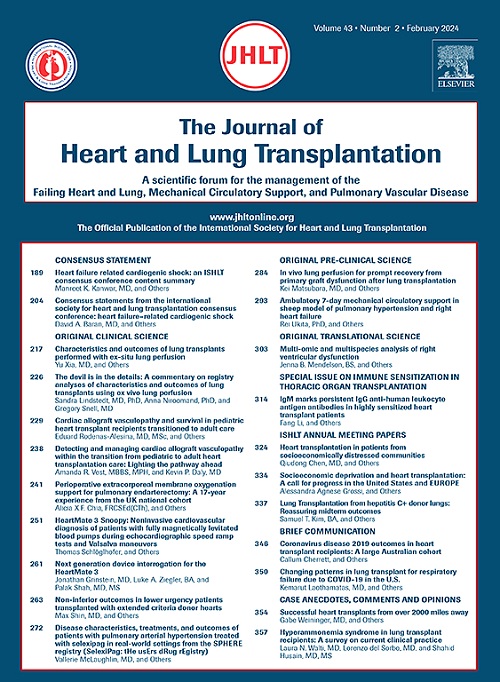美国供体心脏拒绝的原因:供体心脏研究中对14132名移植临床医生的调查结果
IF 6.4
1区 医学
Q1 CARDIAC & CARDIOVASCULAR SYSTEMS
引用次数: 0
摘要
尽管美国心脏移植供体短缺,但大多数潜在的供体心脏都被丢弃了。我们通过对美国HT临床医生的调查来评估其原因及其时间和地理差异。供体心脏研究于2015-2020年在美国招募了4333名成年潜在心脏供体。根据捐赠者的不同,每个拒绝提供该捐赠者的HT中心都被调查了拒绝的原因。我们测量了28种不同的与供体无关的拒绝原因的患病率,并描述了它们的时间和地理差异。结果在收集到的14132份调查中(每份调查都代表一个被拒绝的供体),供体特异性、接受者和不匹配问题分别占49.3%、24.3%和38.0%。在仅引用供体特异性问题的调查中,最常见的是年龄、冠状动脉疾病、左室收缩功能障碍和左室肥厚;其他非心脏问题(例如,药物使用)是20.6%的调查中唯一的原因,仅引用了供体特异性问题。随着时间的推移,尽管年龄较大(50岁以上)的献血者的患病率没有变化,但作为拒绝献血者的原因,年龄越来越普遍。拒绝要约的理由因地区而异,其原因可以用客观供方特征的地区差异来解释。结论我们的发现突出了供体心脏评估的主观性。进一步审查无证据依据的拒绝理由可以减少对可行供体心脏的丢弃。本文章由计算机程序翻译,如有差异,请以英文原文为准。
Reasons for donor heart offer refusal in the United States: Results from 14,132 transplant clinician surveys in the Donor Heart Study
Background
Despite a shortage of donors for heart transplant (HT) in the United States, most potential donor hearts are discarded. We evaluated the reasons why and their temporal and geographic variation using a US-wide survey of HT clinicians.
Methods
The Donor Heart Study enrolled 4,333 adult potential heart donors in United States from 2015-2020. Separately by donor, each HT center that refused an offer for that donor was surveyed on their reason(s) for refusal. We measured the prevalence of 28 distinct donor-unrelated reasons for refusal and characterized their temporal and geographic variation.
Results
Of 14,132 surveys collected—each representing a single declined donor offer—donor-specific, recipient, and mismatch issues were cited in 49.3%, 24.3%, and 38.0%, respectively. Among surveys citing only donor-specific issues, the most common were age, coronary artery disease, left ventricular (LV) systolic dysfunction, and LV hypertrophy; other noncardiac issue(s) (e.g., drug use) were the sole reason in 20.6% of surveys citing only donor-specific issues. Donor age as a reason for offer refusal became increasingly prevalent over time, despite no accompanying change in the prevalence of older (50+ year-old) donors. Reasons for offer refusal varied widely by region, in a manner unexplained by regional differences in objective donor characteristics.
Conclusions
Our findings highlight the subjective nature of donor heart assessment. Further scrutiny of non–evidence based reasons for refusal could reduce discard of viable donor hearts.
求助全文
通过发布文献求助,成功后即可免费获取论文全文。
去求助
来源期刊
CiteScore
10.10
自引率
6.70%
发文量
1667
审稿时长
69 days
期刊介绍:
The Journal of Heart and Lung Transplantation, the official publication of the International Society for Heart and Lung Transplantation, brings readers essential scholarly and timely information in the field of cardio-pulmonary transplantation, mechanical and biological support of the failing heart, advanced lung disease (including pulmonary vascular disease) and cell replacement therapy. Importantly, the journal also serves as a medium of communication of pre-clinical sciences in all these rapidly expanding areas.

 求助内容:
求助内容: 应助结果提醒方式:
应助结果提醒方式:


